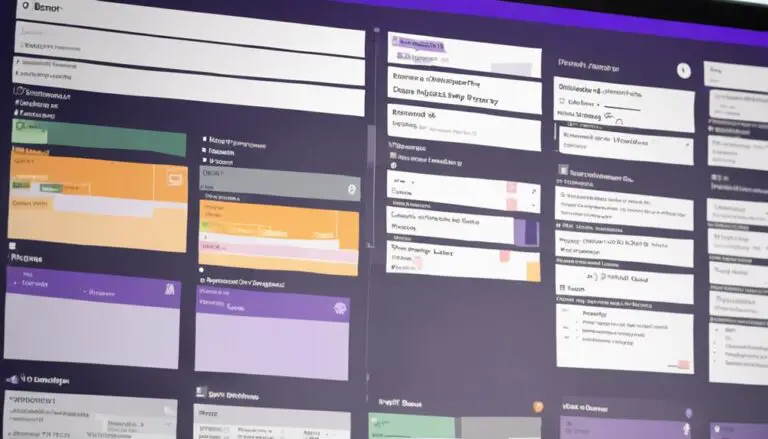Imagine your Kanban board as a bustling train station where tasks are passengers waiting to board different trains representing stages of completion.
You've set up your board, but now you're curious about integrating sprints. Curiosity piqued, you start to envision how creating sprints in your Kanban board could potentially boost your team's productivity and streamline your workflow. As you delve deeper into understanding kanban sprint cycles, you realize that implementing sprints could provide your team with regular time-bound goals and increase their focus and efficiency. By breaking down work into manageable chunks and having regular sprint reviews, you see the potential for continuous improvement and better delivery of value to your customers. This newfound knowledge excites you, and you can’t wait to share it with your team and start experimenting with integrating sprints into your kanban board.
But how exactly can you make this transformation happen seamlessly?
Key Takeaways
- Enhance team focus and efficiency through structured task management.
- Establish a cadence for planning and review meetings to align with workflow.
- Integrate Scrum elements like swimlanes and sprint goals for efficiency.
- Achieve a balance between flexibility and structure to enhance productivity.
Benefits of Combining Sprints in Kanban
By combining sprints in Kanban, you enhance team focus and efficiency in completing tasks. The integration of sprints into the Kanban methodology allows for a structured approach to workflow management. Through the use of sprints, you can achieve better task prioritization by breaking down work into manageable chunks and timeboxing them for completion. This iterative development process fosters a continuous cycle of improvement, enabling you to deliver work regularly and predictably.
Moreover, the incorporation of sprints in Kanban enhances predictability within your team's workflow. Sprint planning not only helps in setting clear goals for each iteration but also provides a framework for refining processes based on past performance. This predictability leads to a more efficient use of resources and time, ultimately resulting in higher productivity and goal achievement. Embracing sprints in Kanban not only streamlines your workflow but also cultivates a collaborative environment focused on achieving shared objectives efficiently.
Establishing Cadence for Planning and Review
To establish a consistent cadence for planning and review within your Kanban framework, prioritize defining the frequency of sprints and allocating dedicated time for these essential meetings. Ensuring a structured process for sprint planning and review is crucial to maintaining a smooth workflow and improving team efficiency.
Here are some key points to consider:
- Set a Clear Frequency: Determine how often sprints will occur based on your team's capacity and project requirements.
- Allocate Dedicated Time: Schedule specific time slots for sprint planning and review meetings to ensure they're prioritized and not overlooked.
- Align with Workflow: Ensure that the cadence of planning and review sessions aligns seamlessly with your team's workflow to maximize efficiency.
- Utilize the Kanban Board: Use the Kanban board to visualize upcoming sprints, track progress, and review completed tasks, fostering transparency and accountability within the team.
Integrating Scrum Elements for Efficiency
Consider integrating key Scrum elements into your Kanban framework to enhance efficiency and streamline your team's workflow. Start by creating swimlanes on your Kanban board for backlog, refinement, and active sprint tasks to incorporate sprint planning seamlessly.
Define sprint goals and timelines within the board to align with Scrum methodology, ensuring clear objectives for your team. Utilize WIP limits in your Kanban board to maintain control over task flow during sprints, preventing overload and promoting focused work.
Implement essential sprint ceremonies such as sprint planning, daily stand-ups, and sprint reviews directly within your Kanban framework to enhance collaboration and communication. Visualize sprint progress and backlog items on the board to monitor sprint velocity and completion rates effectively, enabling you to track performance and make informed decisions.
Achieving Balance Between Flexibility and Structure
When setting up sprints in your Kanban board, it's crucial to strike a balance between flexibility and structure.
By defining clear sprint goals and timelines, you can maintain a sense of organization while remaining adaptable to changing priorities.
Achieving this equilibrium will help your team stay focused and efficient in managing tasks within the sprint intervals.
Flexibility Vs Structure
Achieving a harmonious balance between flexibility and structure in a Kanban board is crucial for optimizing task management efficiency. When considering Flexibility Vs Structure, it's essential to keep in mind:
- Defining Sprint Boundaries: Clearly outlining the limits of each sprint aids in maintaining focus and direction.
- Establishing Sprint Cycles: Creating structured time frames for task completion promotes efficiency and goal achievement.
- Allowing Task Flexibility: Adapting to changing priorities within the sprint structure ensures responsiveness to evolving needs.
- Enhancing Agility and Predictability: Striking a balance between flexibility and structure boosts agility in task management while maintaining predictability in delivery schedules.
Finding the Balance
To strike a harmonious balance between flexibility and structure in a Kanban board, focus on setting clear sprint goals while remaining adaptable to changes. Define sprint timelines and goals within the Kanban framework to provide structure, incorporating sprint planning sessions and time-bound commitments. This ensures a sense of direction while allowing for task reprioritization as needed.
Utilize Kanban flow metrics to track progress and adjust sprint goals dynamically, enhancing adaptability and productivity. By finding the right equilibrium between structure and flexibility, your team can navigate through tasks efficiently and respond effectively to evolving requirements in the Kanban board. Embracing this balance fosters a collaborative environment where achieving sprint goals becomes a collective success.
Enhancing Productivity Through Kanban Sprints
Let's explore how Kanban sprints can boost your team's productivity.
By incorporating sprint planning techniques, you can set clear objectives and prioritize tasks effectively.
Embracing iterative work cycles and continuous improvement strategies within your sprints can enhance workflow efficiency and drive better results.
Sprint Planning Techniques
How can you effectively enhance productivity through Kanban sprints by implementing efficient sprint planning techniques?
When it comes to sprint planning in Kanban, there are key strategies to consider:
- Prioritizing Work Items: Ensure work items in the queue are prioritized based on their importance and dependencies.
- Setting WIP Limits: Utilize WIP limits to control the number of tasks in progress, focusing on completing work before starting new tasks.
- Visualization for Clarity: Visualize sprint commitments and progress to track and optimize workflow efficiency effectively.
- Breaking Down Work: Enhance productivity by breaking down tasks into manageable chunks with clear priorities, aiding in smoother workflow execution.
Iterative Work Cycles
Enhance your team's productivity and focus by incorporating iterative work cycles, known as Kanban sprints, within your Kanban board. These sprints in Kanban offer a structured approach to managing tasks, allowing for flexibility and adaptability in your workflow.
By breaking down work into time-boxed iterations, teams can prioritize effectively, limit work in progress, and deliver value incrementally. Planning, executing, and reviewing work in short cycles empowers teams to enhance efficiency and collaboration.
Embracing Kanban sprints within your process provides a framework for continuous improvement and enables you to respond swiftly to changes. Take advantage of these iterative work cycles to optimize your team's productivity and maximize the value you deliver.
Continuous Improvement Strategies
To boost team efficiency and productivity through Kanban sprints, implement continuous improvement strategies that focus on enhancing workflow clarity and fostering collaboration.
- Set WIP Limits: Utilize WIP limits on your Kanban board to enhance flow and task completion efficiency.
- Analyze Metrics: Use cycle time and lead time metrics to assess task processing efficiency and pinpoint areas for improvement.
- Visualize Bottlenecks: Encourage continuous improvement by identifying and addressing workflow bottlenecks promptly.
- Deliver Customer Value: Measure lead time from task initiation to completion in your Kanban sprints to ensure customer value delivery.
Implementing Fixed Time Frames in Kanban
To implement fixed time frames in Kanban, establish regular intervals for review and planning, akin to sprints used in Scrum. While Kanban typically focuses on continuous flow, incorporating fixed time frames adds a layer of structure and predictability to your workflow.
By defining specific durations for work cycles, you can enhance your team's agility and adaptability without compromising the steady flow of work.
Introducing fixed time frames facilitates regular retrospectives, backlog grooming, and team synchronization, promoting a culture of continuous improvement. These time frames also improve transparency, visibility, and accountability within the team, fostering better collaboration and efficiency.
Improving Workflow Management With Sprints
Incorporating sprints into your Kanban board can significantly boost your team's workflow management efficiency by breaking down tasks into manageable intervals. By implementing sprints, you can enhance your workflow management in the following ways:
- Improved Task Completion: Sprints allow you to focus on completing specific tasks within a set timeframe, leading to a more structured approach to work.
- Enhanced Sprint Planning: Utilizing sprints in your Kanban board helps in better sprint planning by prioritizing tasks and optimizing resource allocation.
- Increased Team Collaboration: Sprints foster team collaboration as members work together to achieve short-term goals, promoting a sense of unity and shared accomplishment.
- Iterative Improvements: Monitoring sprint progress within your Kanban framework enables iterative improvements, leading to increased productivity and better outcomes.
Maximizing Agile Project Efficiency Using Sprints
Maximize your agile project efficiency by integrating sprints strategically into your workflow.
Sprints within a Kanban board not only introduce time-bound iterations for task completion but also enhance project predictability and team focus on short-term goals.
By incorporating sprints into your Kanban system, you enable continuous delivery and incremental progress tracking, leading to improved project predictability.
This approach also allows for better capacity planning and work prioritization, ensuring that your team stays on track and delivers value consistently.
Agile project efficiency is heightened when sprints are utilized in Kanban, providing a balance between flexibility and structured project management.
Embracing sprints within your Kanban framework empowers your team to adapt to changing requirements efficiently while maintaining a steady pace of delivery.
Optimizing Workflows With Kanban Sprint Planning
Enhance your team's workflow efficiency through strategic Kanban sprint planning, optimizing work progress visualization, and task division for streamlined planning. By integrating Kanban sprint planning into your workflow, you can effectively manage task completion and improve overall productivity.
Here are some key strategies to optimize your workflows:
- Visualizing Work Progress: Utilize visual boards to track the progress of tasks, making it easier to identify bottlenecks and areas for improvement.
- Setting WIP Limits: Implement work-in-progress limits to prevent overload, maintain focus, and enhance task prioritization.
- Monitoring Cycle Time: Track the time taken to complete tasks from start to finish, enabling you to identify inefficiencies and streamline processes.
- Encouraging Team Collaboration: Foster a collaborative environment where team members can communicate effectively, share insights, and work together towards achieving common goals.
Frequently Asked Questions
Can We Create Sprint in Kanban Board?
You can create sprints in a Kanban board by structuring tasks in time-bound iterations. Collaborate on sprint planning, iterate work items, prioritize tasks, manage WIP, and continuously improve using agile methodology. Visualize your workflow for effective team coordination.
How Do I Manage Sprints in Kanban Board?
To manage sprints in a Kanban board effectively, start by facilitating sprint planning for clear goals. Encourage team collaboration, prioritize tasks, visualize workflows, track cycle times, improve continuously, and communicate with stakeholders regularly.
How Do I Convert My Kanban to Sprint?
To convert your Kanban board to sprints, you'll create a new Scrum board in Jira. This shift enables agile sprint planning, team collaboration, task prioritization, and continuous improvement with effective time tracking and work in progress visibility.
Does Kanban Have Sprint Goals?
In Kanban, sprint goals are absent. Instead, focus on continuous delivery, optimizing workflow efficiency, and task completion. Assign tasks immediately, without predefined sprint durations. Emphasize team capacity, daily stand-ups, task estimation, backlog grooming, and cycle time tracking for success.
Conclusion
In conclusion, by incorporating sprints into your Kanban board, you can enhance productivity, efficiency, and collaboration within your team.
Like a well-oiled machine, your workflow will become smoother and more structured, allowing for better planning and review processes.
So, don't hesitate to integrate sprints into your Kanban approach and watch as your project management reaches new heights of success.





